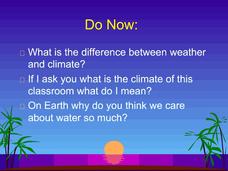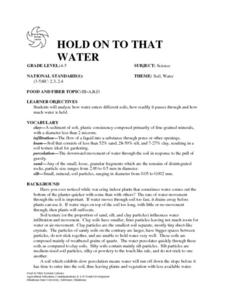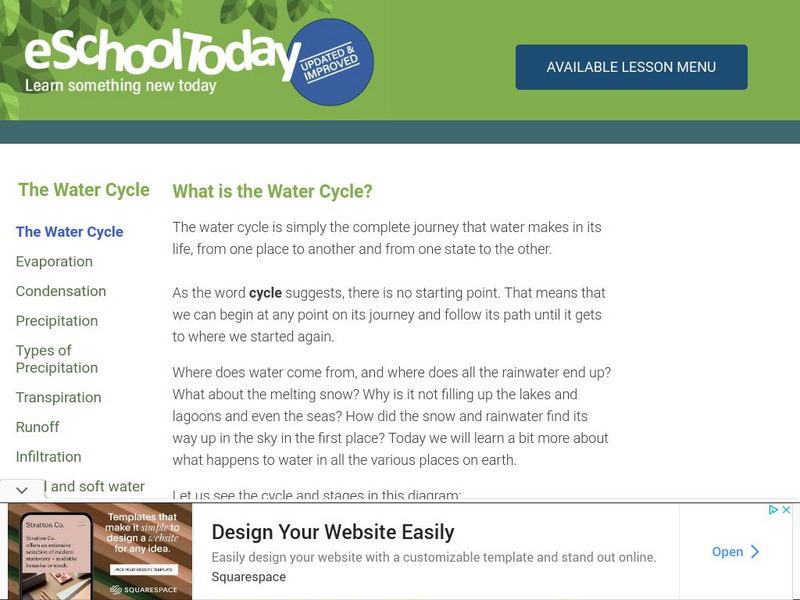Port Jefferson School District
Water and Climate
Dive into a lesson on the hydrosphere with this Powerpoint presentation. Building on prior knowledge of the water cycle, young scientists learn what happens to water after it falls as precipitation and explore the different factors...
University of Wisconsin
Infiltration Test: Exploring the Flow of Water Through Soils
Soil scientists gain experience with an infiltrometer can to determine the infiltration rates at different locations on campus. If you are using the entire unit, the class has already analyzed water flow and soil types, so they should...
Curated OER
Soil Water Worksheet #1
Drawings of four groups of soil particles of varying sizes are displayed across the page for soil scientists to examine. As they complete the worksheet, place a set of similar soils at each table for hands-on experience. In this way,...
Curated OER
Local Hydrologic Cycle
Students draw the water cycle as it occurs in their community. In this water cycle lesson, students observe demonstrations of sublimation and infiltration. They also use photographs or their own drawings of their environment to label...
Curated OER
Ground Surfaces and Infiltration
Students study permeability and apply the concept to different types of ground materials. In this ground surfaces lesson students complete a lab and fill out a table of their results.
Curated OER
HOLD ON TO THAT
Students will analyze how water enters different soils, how readily it passes through and how much water is held.1. Materials needed for the activity are; pint of clay, pint of sand, pint of loam, newspaper,
three frozen fruit juice...
Curated OER
Ports in the Storm
Students explore national security issues related to the possibility of a Dubai-owned company operating an American port. Opinions are solicited and debated.
eSchool Today
E School Today: Your Revision Notes on the Water Cycle
Learn about the different stages of the Earth's water cycle, and about processes involving water, including runoff, infiltration, and the differences between hard and soft water.
TeachEngineering
Teach Engineering: Natural and Urban "Stormwater" Water Cycle Models
Students apply their understanding of the natural water cycle and the urban stormwater water cycle, as well as the processes involved in both cycles to hypothesize how the flow of water is affected by altering precipitation.
TeachEngineering
Teach Engineering: Does Media Matter? Infiltration Rates and Storage Capacities
Students gain a basic understanding of the properties of media- soil, sand, compost, gravel- and how these materials affect the movement of water (infiltration/percolation) into and below the surface of the ground.
TeachEngineering
Teach Engineering: Making "Magic" Sidewalks of Pervious Pavement
Students use everyday building materials- sand, pea gravel, cement and water- to create and test pervious pavement. Groups are challenged to create their own pervious pavement mixes, experimenting with material ratios to evaluate how...
Other
Virtual Field Trip: Water/aquifers
This virtual field trip for middle school students looks at aquifers and their place in the hydrologic cycle. Students learn why and how it is important to protect the source of your drinking water and some unique details about the...
Science Buddies
Science Buddies: Make a Miniature Water Cycle Model
In this activity, you will investigate some of the processes that make water move in and out of the atmosphere by making a miniature water cycle model inside a plastic bag.
Missouri Botanical Garden
Missouri Botanical Garden: Rivers and Streams
The Evergreen Project profiles the natural history of rivers and streams. Topics include watersheds, how a stream becomes a river, erosion, water pollution, and the like.
PBS
Pbs Learning Media: Earth's Water Movements
The paths that water can take through Earth's systems are many and complex. Examine the following diagram from NASA depicting the water cycle. Studying the water cycle is important because changes in the water cycle affect all parts of...
US Geological Survey
Usgs: The Water Cycle
Learn about the movement of water from Earth's surface to the atmosphere with this site. Site describes the water cycle in words and with a diagram. Also explored on the page is the distribution of Earth's global water supply.
Cornell Lab of Ornithology
Habitat Network: Rain Gardens
Get some tips and strategies to create a sustainable rain garden.
University Corporation for Atmospheric Research
Ucar: The Water Cycle
This site provides a comprehensive introduction to the water cycle. Students construct a model to simulate parts of the water cycle. Includes background information, links to standards, lesson plans, and assessment ideas.
CK-12 Foundation
Ck 12: Fifth Grade Science: Earth Science: Water on Earth
[Free Registration/Login may be required to access all resource tools.] Discusses water and where it occurs on Earth, gives an overview of the water cycle, and explains how the ocean is an integral part of the water cycle and is...
Cosmo Learning
Cosmo Learning: Water Resources Engineering
A collection of video lectures from a course on water resources engineering. Webpage includes twenty-eight lectures from a professor at the National Programme on Technology Enhanced Learning. Lectures vary in length and cover topics like...
Other
Warm Air: Heat Loss
An excellent page describing the variables which effect the heat loss through homes. The causes and sources of such heat loss are identified and explained. Lays the groundwork for understanding the importance of and need for home heating...
NOAA
Noaa: National Weather Service: Simplified Hydrologic Cycle
The National Weather Service offers information on the processes that make up the water (hydrologic) cycle, including evaporation and transpiration, precipitation, run-off, infiltration, and percolation. Has a good illustration and...
Science Struck
Science Struck: A Simple Guide to the Steps of the Water Cycle
The steps in the water cycle and the processes that occur are explained in this resource.


















